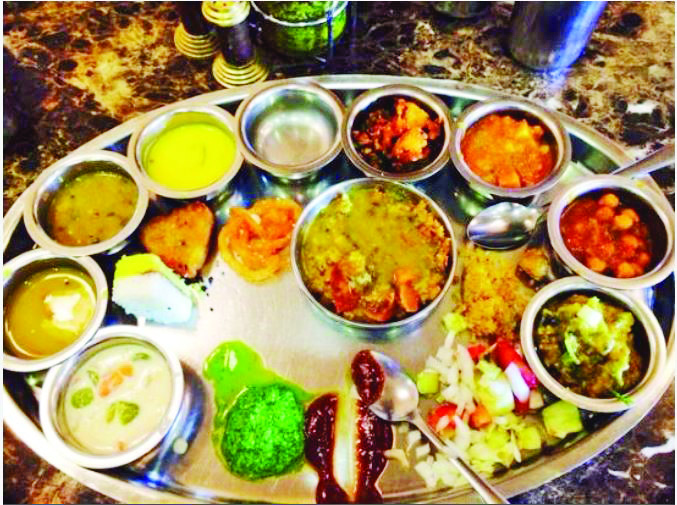Goa is abuzz with excitement as vintage bike and car owners, users, collectors and fans are decking […]

THE OLDER I GET AND ALL THAT
Jan 05- Jan 11 2019, Life & Living January 5, 2019Maybe all we need for a happier, healthier tomorrow is to eat as our grandparents did in yesteryears…
BY TARA NARAYAN
Eating is Fun / Eating is Yuck! – A variety food column
IT’S that time of the year when I do remember the loved ones gone with the wind and funny, the older I get the more I want to go back to eating like my grandparents — and emulating their hardworking yet simple lifestyle philosophy! I’m sure you’ve heard that before but just to detail it some more…while my paternal grandparents were from poor farming stock and my grandfather here died of a some mysterious disease early in life, it was my grandmother who had to be stoic and earn a grinding living to educate both my father and foi (or father’s sister).
Even then as a young boy growing up and dealing with impoverishment post-Independence village life in Bhadran in Gujarat, my father was your typical male chauvinist pig as we say and didn’t want my grandmother to educate his sister. Good for her, his mother, my paternal grandmother Kashiba told him to mind his own business and my foi got educated, passed her matric exams which meant she was educated and her chances of marrying into a richer household brighter. Yes, she did marry well and moved up the economic scale in Chembur in Mumbai and to a better provided for comfort and wellbeing, the envy of many others!
But here again the man she married, my uncle or fua, was your typical Indian male chauvinist pig and took it for granted that she should be enshrined in the kitchen cooking endlessly for a large joint family and of course, she was supervised by her mother-in-law whom we all called Ba (a strict martinet but of a far more positive outlook than my paternal grandmother Kashiba in village Gujarat).
Anyway, with women of the home cooking in the kitchen, meals were pretty much taken for granted and it’s always nice to have plenty of food to eat at home! Generally speaking, I remember my mother and foi together clueing me up on the essentials of Gujarati cooking and the admonishment was always, “Better learn to cook or nobody will marry you!” Mercifully nobody insisted I also learn how to sing and dance too (as a Bengali friend of mine tells me) to impress whoever the future bridegroom would be.
To stay with the essentials of Gujarati village-style cooking I must say it was as primary as one could get. In my village Bhadran cow-dung plastered home I relished my mother’s pearl millet rotla (bajri-na-rotla) laced with home-made ghee (kept in a wall cupboard and its treasures controlled by Kashiba, everything to be doled out in appropriate amounts). Lunch was usually the thin Guju fulka, rotli, tuver-ni-dar, a vegetable and rice. In the evenings rotla used to be a regular affair served with buttermilk kadi, sweetened a wee bit with a nugget of naturally organic golden brown gor (sugarcane jaggery), some groundnut or green woodapple chutney. Or there could be tuver or maag-ni-dar-ni-kichdi in the evenings with a bowl of milk. Or could be just leftover rotlo crushed into a bowl of milk!
As a little girl of four years something, Kashiba would give me a cloth theli, some purchuran anna and tell me to run down the sandy lane to buy fresh dairy milk from a neighbour or to the village market close by to buy some groundnut or sesame seed oil. I also had a stainless steel dabba with a neat handle and some veggies listed out for me. I managed to do the shopping with various folk smiling, greeting, helping me along. I tried not to dawdle anywhere because Kashiba had a caustic tongue (interestingly, she didn’t want me to live when I was born as the first child, a girl, and advised my mother to dab some oleander plant sap poison in my mouth and shove me down the pit latrine quietly). My mother refused to take the advice.
So I was allowed to live and my memories of simple honest Gujarati country food are very strong to this day. Special days there would be sheero, kaunsar, dudhpaak, shrikand, choorma ladoo…all sweetened with gor and desi ghee if mandatory. My mother could cook and didn’t take too kindly if Kashiba hinted she wasn’t up to the mark as required and didn’t get a recipe right (I mean my mother came from a richer household, but there was no question of back-answering in those days when she had to keep her face half-hidden in modesty with her saree paloo). Certain formalities had to be maintained between bahu and sasumai and Kashiba’s temperament softened with age and ill-health.
And mercifully when the children came one after another (all my three sisters and two brothers were born out in Penang in Malaysia where my father had later migrated soon after I, the eldest, was born in Viramgam in Gujarat)…but to this day I remember how in Bhadran village Kashiba loved good food. She was a keen connoisseur of such piece de resistance fare as dar-dhokli (to be made with any leftover dal from lunch), bajri-no-lot (steamed pearl millet flour in sour buttermilk and lots of garlic, to be eaten laced with fresh cold-pressed sesame seed oil I got it from the local buffalo driven ghani), and this is to say even the whole wheat bhakri tasted divine and to live for when eaten with leeli-tuver-nu-shaak (seasonal green lentils cooked usually with purple aubergine with in an ajwain-garlic tempering). There was always fresh buttermilk to drink (curd was made after the milk cream for making ghee was removed).
AND this new year I’m also thinking how hard my mother had to work to keep the household fed. Of course, out in Penang she didn’t have to go out to earn a living and was more or less happy doing her household duties keeping everyone in family and whoever came calling welcome and well fed! Later on in Penang she became famous with friends for her handvo (lentil flour savoury cake, sesame seeds flecked and backed on coal sigdi) and soont-spiked gor-ni-sukdi (gingerbread Guju style, hard to do for if you don’t get it right the sukdi becomes chewy and not flaky).
Well, all this and much more. There were also my maternal grandparents home too in Karamsad (Sardar Vallabhai Patel’s home village) where I spent some of my childhood life and times. My maternal grandmother used to make us laugh with her name being Samjuba and there was my very educated grandfather here Sakarlal….I still retain this picture in my mind about an impossibly aged, bent Samjuba parking herself out in the courtyard (my maternal grandfather or dada had a spacious village home in Karamsad for he was employed in British time railways).
When her active life was over Samjuba loved basking in the sunshine of the wintry months and picking, cleaning or cutting this, that or the other placed before her by one of her daughters-in-laws. Old or young, women always had to be useful in the old days or they earned a few sharp words from somebody! Dinners became more and more simple as the years passed by and both dada and dadi were happy if a fine ghee-laced rotli or wheat bhakri or better still a bajra no rotlo was crushed in a bowl full of milk in the evenings, sweetened with a small nugget of gor.
I adored my Shakar-dada because he would take me along on his walks to the local temple and buy me roasted “sing-chana” or peppermints. As he grew on in years he would be happy with a rotli crushed in a bowl full of milk or just a banana for dinner. My maternal grandparents lived to a ripe old age in their 80s and 90s and I can’t help thinking it was because their meals were more nutritious and they were evenly tempered…they truly died graciously of old age and not the stresses of having greedy, selfish, cruel children controlling them for material benefits. (Never mind if some son did turn out to be the kind who said “I took care of parents in their old age so everything they own is all mine!”)
The irony is that I see so many of my relatives settled in the USA or London, while the family homes they fought over so childishly back in their Gujarat villages in earlier years to hurt one another bitterly…now rot and fall apart, infested with termites, unlived in or rented out for paltry rents. Such is the transformation over three generations as attitudes harden to concrete and a younger generation knows nothing of how their grandparents lived with far more grace under duress than they are able to do today with more material comforts at their disposal.
Today we live to eat and die of too much complicated depression, lack of routine exercise and diseases beginning with diabetes, heart disease, I see cancer all around me in and out of family…few grow old to die and leave behind the kind of educative, comforting, happy memories I have vis-a-vis my grandparents! Perhaps that’s why today in my ripe old terminal 60s I want to make efforts to recapture the simple living of my grandparents’ generation…in the hope that if life returns to basics and primaries the mind too will realise that a lot of needless and superfluous software garbage clutters it up and choke it to death.
So my one big 2019 resolution is to simplify my needs, wants, and to hell with greed! Join me in searching that minimalistic lifestyle which I notice even some folk amongst today’s younger generation are seeking — having seen through the follies of our desperately seeking material lifestyles …yes, all in the larger interests of rescuing Mother Earth and their soul. A bit like what the old lady in the film `Titanic’ tells her granddaughter, remember? Eat to live and not live to eat to stay alive and kicking in 2019!















